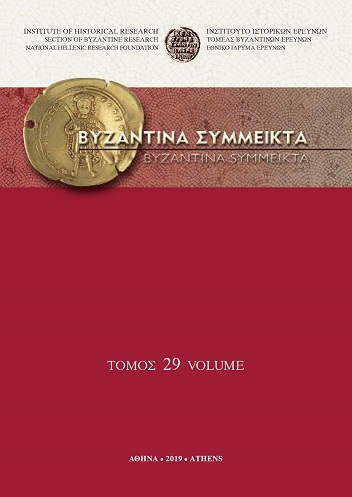Ο βυζαντινός στρατός των Αγγέλων, μέσα από τις περιγραφές των λατίνων αντιπάλων του
Abstract
The Byzantine Army of the Period of the Angeli, according to the Accounts of the Latin Sources
There is hardly any information available about the byzantine army under the dynasty of Angeli, about its numbers, composition and performance in battle. With the exception of Choniates no other byzantine gives any useful information. Under this prism the western European sources of the third and fourth crusades could provide valuable information, if properly read. Chronicles such as Historia de expeditione Friderici imperatoris and the Historia Peregrinorum from Germany and the Itinerarium peregrinorum and the Estoire de la guerre sainte of Ambroise from England together with the famous and much read chronicles of Robert Clari and Geoffroi Villehardοuin from France give a very different account than usual about the true capabilities of the byzantine army on the eve of the fourth crusade. The information derived from these sources picture a very grim situation for the byzantine state in general. The army was greatly outnumbered by its foes, without capable leadership and enough reserves to defend even the capital. Nevertheless, when properly handled it could still be a dangerous opponent for the superior crusader armies.
Article Details
- How to Cite
-
ΑΛΕΞΟΠΟΥΛΟΣ Θ. (2019). Ο βυζαντινός στρατός των Αγγέλων, μέσα από τις περιγραφές των λατίνων αντιπάλων του. Byzantina Symmeikta, 29, 231–247. https://doi.org/10.12681/byzsym.17688
- Issue
- BYZANTINA SYMMEIKTA 29
- Section
- Articles

This work is licensed under a Creative Commons Attribution-NonCommercial-ShareAlike 4.0 International License.
Copyright: The copyright for articles in this journal is retained by the author(s), with first publication rights granted to the journal. By virtue of their appearance in this open access journal, articles are free to use (with the exception of the non-granted right to make derivative works) with proper attribution for non-commercial uses (licence Creative Commons 4.0). NHRF retains the worldwide right to reproduce, display, distribute, and use articles published in BYZANTINA SYMMEIKTA in all formats and media, either separately or as part of collective works for the full term of copyright. This includes but is not limited to the right to publish articles in an issue of the Journal, copy and distribute individual reprints of the articles, authorize reproduction of articles in their entirety in another NHRF publication, and authorize reproduction and distribution of articles or abstracts thereof by means of computerized retrieval systems.



